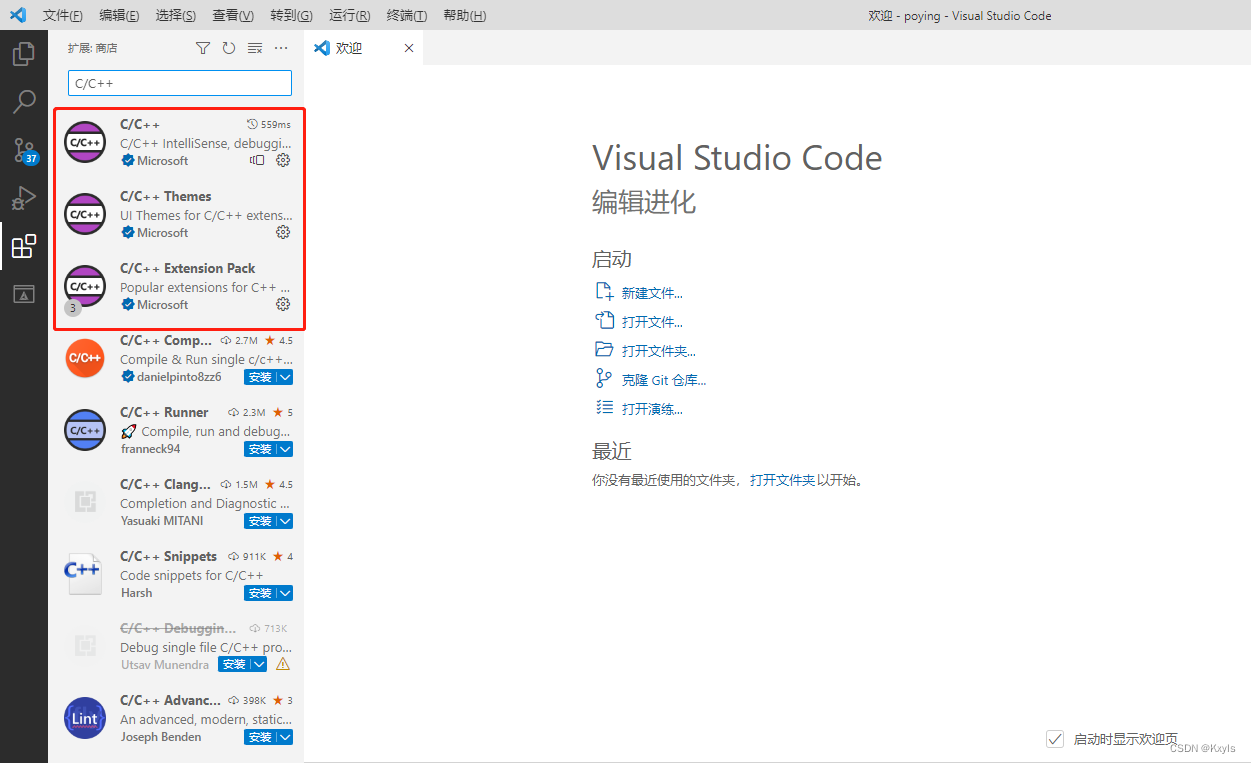构建C++语言开发环境
系统环境
系统:window11
开发工具:Visual Studio Code
维护:vcpkg
工程:CMake工程
构建步骤
-
安装Visual Studio Code:
访问Visual Studio Code官网(https://code.visualstudio.com/)并下载安装程序。运行安装程序并按照提示完成安装。

-
安装必要的Visual Studio Code扩展:
打开Visual Studio Code,依次点击左侧边栏的Extensions图标,在搜索框中输入以下扩展名称,并点击安装:
- C/C++ (by Microsoft)
- CMake (by Microsoft)
- CMake Tools (by Microsoft)

-
安装C++编译器(例如MSVC或MinGW):
对于MSVC,您需要安装Visual Studio 2019或更高版本。在安装过程中,请确保选择"Desktop development with C++"工作负载。下载地址:https://visualstudio.microsoft.com/downloads/

如果已经安装可以用以下方法查看工作负载的安装情况:
-
在 Windows 的“开始”菜单中,可以搜索“安装程序”,然后从结果中选择“Visual Studio 安装程序”。

-
运行 Visual Studio 安装程序可执行文件,该可执行文件位于以下路径:
C:\Program Files (x86)\Microsoft Visual Studio\Installer\vs_installer.exe -
如果你打开了 Visual Studio,请选择“工具”>“获取工具和功能…”,这会打开 Visual Studio 安装程序。

对于MinGW,您可以从其官方网站(https://www.mingw-w64.org/)下载安装程序。安装过程中,选择合适的架构和版本。
-
安装CMake:
访问CMake官网(https://cmake.org/download/)并下载Windows安装程序。运行安装程序,按照提示完成安装。在安装过程中,请确保勾选"Add CMake to the system PATH for all users"或"Add CMake to the system PATH for the current user"。
或者手动加载环境变量:

-
安装vcpkg:
打开命令提示符,然后克隆vcpkg仓库并构建vcpkg:
git clone https://github.com/microsoft/vcpkg.git cd vcpkg .\bootstrap-vcpkg.bat然后,将vcpkg添加到系统PATH中:
setx PATH "%PATH%;C:\path\to\vcpkg"请将
C:\path\to\vcpkg替换为实际的vcpkg目录。 -
使用vcpkg安装必要的库:
使用
vcpkg命令安装所需库。例如,要安装boost,您可以运行:vcpkg install boost如果需要为不同的平台或编译器安装库,可以使用
--triplet选项。例如,要为x64平台安装库,运行:vcpkg install boost --triplet x64-windows -
配置Visual Studio Code的
settings.json文件:在项目的
.vscode文件夹中创建或修改一个名为settings.json的文件。如果您还没有这个文件夹,请在项目根目录中创建它。然后,在settings.json文件中,添加以下内容:{ "cmake.configureSettings": { "CMAKE_TOOLCHAIN_FILE": "C:/path/to/vcpkg/scripts/buildsystems/vcpkg.cmake" } }请将
C:/path/to/vcpkg替换为实际的vcpkg目录。-
创建或修改项目的
CMakeLists.txt文件:在项目根目录中创建或修改一个名为
CMakeLists.txt的文件。添加必要的CMake命令,例如project()、find_package()以及add_executable()等,以及库的链接设置。 -
使用CMake Tools配置和构建项目:
在Visual Studio Code中,点击左侧边栏的CMake图标。点击“Configure”按钮,选择一个构建目录(例如
build文件夹)。CMake Tools将自动运行CMake,并使用先前配置的settings.json文件中的设置。构建完成后,点击“Build”按钮来编译项目。如果一切顺利,您将在构建目录下找到可执行文件。
-
运行和调试项目:
要运行和调试项目,请在Visual Studio Code的
Run and Debug界面中设置启动配置。在.vscode文件夹中创建一个名为launch.json的文件,并添加适当的调试配置,例如:{ "version": "0.2.0", "configurations": [ { "name": "C++ Launch", "type": "cppvsdbg", "request": "launch", "program": "${workspaceFolder}/build/your_executable_name.exe", "args": [], "stopAtEntry": false, "cwd": "${workspaceFolder}", "environment": [], "externalConsole": false, "preLaunchTask": "build" } ] }请将
your_executable_name.exe替换为实际的可执行文件名。保存launch.json文件后,返回Run and Debug界面,选择刚刚创建的配置,并点击“Run”或“Debug”按钮。按照以上步骤,您应该已经成功地在Windows 11上使用Visual Studio Code搭建了一个C++项目,系统开发环境使用vcpkg进行维护,并采用CMake工程。祝您开发顺利!
-





















 9807
9807











 被折叠的 条评论
为什么被折叠?
被折叠的 条评论
为什么被折叠?








